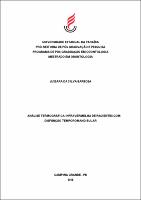| Compartilhamento |


|
Use este identificador para citar ou linkar para este item:
http://tede.bc.uepb.edu.br/jspui/handle/tede/3176| Tipo do documento: | Dissertação |
| Título: | Análise termográfica infravermelha de pacientes com disfunção temporomandibular |
| Autor: | Barbosa, Jussara da Silva  |
| Primeiro orientador: | Bento, Patrícia Meira |
| Primeiro coorientador: | Maia, Ana Marly Araujo |
| Primeiro membro da banca: | Melo, Daniela Pita de |
| Segundo membro da banca: | Batista, André Ulisses Dantas |
| Resumo: | Disfunção Temporomandibular (DTM) é um termo coletivo que se refere a um conjunto de alterações que compartilham sinais e sintomas comuns e dor e/ou disfunção. O objetivo deste estudo foi analisar, por meio da termografia infravermelha, o aspecto termográfico de pacientes com DTMs. Tratou-se de um estudo transversal, realizado no Departamento de Odontologia da Universidade Estadual da Paraíba (UEPB), com aprovação do Comitê de Ética em Pesquisa (UEPB) sob o seguinte CAAE: 73417017.2.0000.5187. (Research Diagnos tic Após diagnóstico pelo RDC/TMD Criteria for Temporomandibular Disorders) e o questionário anamnésico de Fonseca, os pacientes foram convidados a participar da pesquisa, com uma amostra por conveniência de 62 pacientes, de acordo com a presença de DTM: Grupo DTM (n= 35): Pacientes com DTM muscular ou mista (com diagnóstico muscular e articular) e Grupo Controle (n= 27): Pacientes não diagnosticados com DTM. Seguido do exame clínico, os pacientes receberam orientações para a realização das imagens termográficas em norma lateral direita e esquerda de forma padronizada, demarcadas por máscara facial guia. As regiões de interesse foram os músculos masseter e temporal anterior e a ATM, de ambos os lados. As imagens foram analisadas em ROIs de dimensão e localização similar por meio do Flir Tools software e correlacionadas com a intensidade de dor à palpação. A análise estatística inferencial e comparativa utilizou o teste t para amostras independentes, o teste de intergrupos ANOVA e o teste de correlação de Sperman, com nível de significância em 5%. Ambos os pacientes acometidos ou não por DTMs apresentaram temperatura média absoluta e adimensional sem diferenças estatísticas (p>0,05) em todas as ROIs analisadas, sendo a região do temporal anterior com a maior média entre as ROIs. Na análise de simetria lateral, observou-se maior assimetria apenas no masseter médio de pacientes com DTM, quando correlacionado a temperatura com a intensidade de dor à palpação, foi observada correlação positiva apenas região da ATM direita (p=0,011). Os pacientes com e sem DTMs apresentaram a temperatura similar dificultando a diferenciação do quadro de DTM por meio da análise termográfica nas condições realizadas. |
| Abstract: | Temporomandibular Dysfunction (TMD) refers to a set of orofacial pain; joint sounds; limited movement or jaw deviation; masticatory difficulty; and other functions of the stomatognathic system that are muscle-dependent altered. The objective of this study was to analyze, through infrared thermography, the thermographic aspect of TMD patients. This was a cross-sectional study carried out at the Department of Dentistry of the State University of Paraíba (UEPB), with the approval of the Research Ethics Committee (UEPB) under the following CAAE: 73417017.2.0000.5187. After diagnosis by the RDC/TMD (Research Diagnostic Criteria for Temporomandibular Disorders) and Fonseca's anamnestic questionnaire, patients were invited to participate in the study, with a convenience sample of 62 patients, according to the presence of TMD: TMD Group (n = 35): Patients with muscular or mixed TMD (with muscle and joint diagnosis) and Control Group (n = 27): Patients not diagnosed with TMD. Following the clinical examination, the patients received guidelines for thermographic images in a standard right and left lateral pattern, marked by a facial mask. The regions of interest were the anterior and temporal masseter and TMJ muscles, on both sides. The images were analyzed in ROIs of similar size and location by means of Flir Tools software and correlated with the intensity of pain upon palpation. Inferential and comparative statistical analysis used the t test for independent samples, the ANOVA intergroup test and the Sperman correlation test, with a significance level of 5%. Both TMD and non-TMD patients are mean weighted averages and dimensional differences (p> 0.05) in all ROIs analyzed, being a region of the previous temporal with the highest average between ROIs. In the analysis of lateral symmetry, observed a greater asymmetry was not observed the average of patients with TMD, when correlated the temperature with the intensity of the pain to the palpation, the purely aerial region of ATMândia was observed (p = 0.011). Patients with and without TMD compared the temperature to the TMD pattern. |
| Palavras-chave: | Articulação temporomandibular Termografia Músculo masseter Músculo temporal Thermography Temporomandibular Joint Masseter Muscle Temporal Muscle |
| Área(s) do CNPq: | CIENCIAS DA SAUDE::ODONTOLOGIA |
| Idioma: | por |
| País: | Brasil |
| Instituição: | Universidade Estadual da Paraíba |
| Sigla da instituição: | UEPB |
| Departamento: | Pró-Reitoria de Pós-Graduação e Pesquisa - PRPGP |
| Programa: | Programa de Pós-Graduação em Odontologia - PPGO |
| Citação: | BARBOSA, J. da S. Análise termográfica infravermelha de pacientes com disfunção temporomandibular. 2018. 90f. Dissertação (Programa de Pós-Graduação em Odontologia - PPGO) - Universidade Estadual da Paraíba, Campina Grande, 2018. |
| Tipo de acesso: | Acesso Aberto |
| URI: | http://tede.bc.uepb.edu.br/jspui/handle/tede/3176 |
| Data de defesa: | 19-Jul-2018 |
| Aparece nas coleções: | PPGO - Dissertações |
Arquivos associados a este item:
| Arquivo | Descrição | Tamanho | Formato | |
|---|---|---|---|---|
| PDF - Jussara da Silva Barbosa.pdf | PDF - Jussara da Silva Barbosa | 32.05 MB | Adobe PDF |  Baixar/Abrir Pré-Visualizar |
Os itens no repositório estão protegidos por copyright, com todos os direitos reservados, salvo quando é indicado o contrário.




